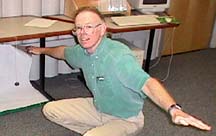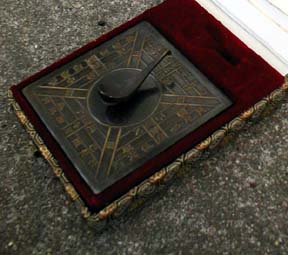The Earth is full of surprises.

The Earth is full of surprises.

Introduction
Magnetic poles were originally defined with respect to the earth. In this activity we will repeat some of the earliest experiments conducted on magnets, finding that they have poles and then naming the poles. We will also do some experiments to explore the interactions of magnetic poles.
Material
Assembly
Tie or tape the string to each magnet.
Or use two magnets and stick them together with the string between them.
To Do and Notice
Hang the magnets from the edge of a table. Keep the magnets over a meter from each other.
Watch what happens to them.
After the magnets stop moving have one person near each magnet hold
both arms straight out lined up with the magnet.
(Have them treat the magnet as a wheel and make their arms point
along a line through the wheel just as if they were an axle.)
Look around. Most, if not all of the people will have there arms
parallel to each other.
What are the chances of this alignment happening by accident? The
chances are slight.
(If you doubt this hang steel washers and compare their alignment to
that of the magnets.)
Have everyone present agree to point one arm through the magnet so
that everyone is pointing to the same wall of the room.
Everyone then marks the face of their magnet with a stick-on dot on
the side of the magnet facing the chosen wall.
Call the faces of the magnet dot and nodot.
Use a compass to find the north side of the room. Is the dot side of
your magnet on the north side or the south side?
So What?
Two cultures noticed this alignment of
magnets.
Each chose a different one of the two possible directions to define
the way magnets pointed.
The Chinese chose the south pointing end, while the Europeans chose
the north pointing end. In choosing to mark the end of your magnet
did you make the same choice as the Chinese or Europeans? The Chinese
belief in geomancy gave extra value to the southerly direction. While
the European cultures had already adopted the north star as a
navigational tool and saw the magnetic needle of a compass as a way
to locate the north star when it was not visible.
What’s Going On?
Each end of your magnet is a magnetic pole.
The pole that points toward the north was originally called the
"north seeking pole." Later, that name was shortened to "the north
pole." The other end is then the south pole.
Why the north pole of a magnet "seeks" the north pole of the earth
was discovered by William Gilbert in the 1600's but before we look
into that story do the activity titled "Simple
Magnetic Poles."
Etc
Europeans discovered natural stones that were magnets. These were called "leadstones" because they could be used to lead navigators. Later the word changed to lodestones.
The mineral these stones were made from is
magnetite, Fe3O4.
The Chinese also used lodestone, they carved it into spoon shapes
which then rotated on a brass base so that the handle of the spoon
pointed south.

Etc
Today, many definitions are determined by "standards committees," these groups meet to define things like where is the north pole of a planet. In asking a class to decide on one of two possible directions for their magnets, you have asked the class to become a standards committee.
View as a pdf for printing.
|
Scientific Explorations with Paul Doherty |
|
7 January 2008 |